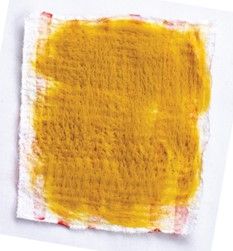Yellow Ant Colony
Description: With a poplin base, dresses, shirts, trousers, and jackets could be made with this fabric depending on the thickness of the layers of wool applied.
Textile/Material: A slightly shredded white poplin fabric with a smooth layer of wool on the inside and small hairy sprouts on the outside. A bright red print contrasts with the yellow spurs pierced through it.
Impact on Planet/People/Animals: The poplin base fabric was sourced from the AMFI textile bins, a student's leftovers from a project. Merino wool is one of the most sustainable wools produced. This particular one is produced in the EU, sourced from a small-scale farm that follows organic production principles, guarantees a mulesing-free process, and prioritizes animal welfare.
Construction:
- Composition: 65% CO, 35% WO
- Raw Materials: Cotton, Wool, Merino Wool
- Coloration: Piece bleached, Fiber dyed, upon printed
- Sourcing: AMFI and Meaningful Crafts
- Weave: Weave + Non Woven
Circularity: The great thing about needle punching as a technique is that fibers and fabrics can be reused over again. The wool can be removed and repurposed from this sample. Its soft quality will have diminished, but in any case, needle punch felting is extremely flexible and versatile, and recycled wool can add an extra element and quality that may not be achieved with new wool. It is something that can be explored and appreciated in its own way.
Recipe: A print inspired by shapes found in ants' nests was block printed onto a poplin fabric. Three thin layers of wool fiber were laid out on the inside of the poplin. Using an industrial needle punching machine at studio Boldwool, I passed the fabric three times through the machine. I ensured to keep the yellow side facing up towards the needles so that they would punch the fibers downwards through the poplin base.
